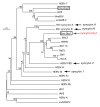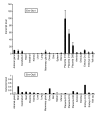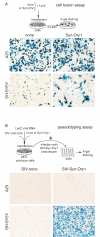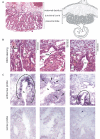Identification of an endogenous retroviral envelope gene with fusogenic activity and placenta-specific expression in the rabbit: a new "syncytin" in a third order of mammals
- PMID: 19943933
- PMCID: PMC2789053
- DOI: 10.1186/1742-4690-6-107
Identification of an endogenous retroviral envelope gene with fusogenic activity and placenta-specific expression in the rabbit: a new "syncytin" in a third order of mammals
Abstract
Background: Syncytins are envelope genes of retroviral origin that have been co-opted by the host to mediate a specialized function in placentation. Two of these genes have already been identified in primates, as well as two distinct, non orthologous genes in rodents.
Results: Here we identified within the rabbit Oryctolagus cuniculus-which belongs to the lagomorpha order- an envelope (env) gene of retroviral origin with the characteristic features of a bona fide syncytin, that we named syncytin-Ory1. An in silico search for full-length env genes with an uninterrupted open reading frame within the rabbit genome first identified two candidate genes that were tested for their specific expression in the placenta by quantitative RT-PCR of RNA isolated from a large set of tissues. This resulted in the identification of an env gene with placenta-specific expression and belonging to a family of endogenous retroelements present at a limited copy number in the rabbit genome. Functional characterization of the identified placenta-expressed env gene after cloning in a CMV-driven expression vector and transient transfection experiments, demonstrated both fusogenic activity in an ex vivo cell-cell fusion assay and infectivity of pseudotypes. The receptor for the rabbit syncytin-Ory1 was found to be the same as that for human syncytin-1, i.e. the previously identified ASCT2 transporter. This was demonstrated by a co-culture fusion assay between hamster A23 cells transduced with an expression vector for ASCT2 and A23 cells transduced with syncytin-Ory1. Finally, in situ hybridization of rabbit placenta sections with a syncytin-Ory1 probe revealed specific expression at the level of the junctional zone between the placental lobe and the maternal decidua, where the invading syncytial fetal tissue contacts the maternal decidua to form the labyrinth, consistent with a role in the formation of the syncytiotrophoblast. The syncytin-Ory1 gene is found in Leporidae but not in Ochotonidae, and should therefore have entered the lagomorpha order 12-30 million years ago.
Conclusion: The identification of a novel syncytin gene within a third order of mammals displaying syncytiotrophoblast formation during placentation strongly supports the notion that on several occasions retroviral infections have resulted in the independent capture of genes that have been positively selected for a convergent physiological role.
Figures







Similar articles
-
Capture of syncytin-Mar1, a fusogenic endogenous retroviral envelope gene involved in placentation in the Rodentia squirrel-related clade.J Virol. 2014 Jul;88(14):7915-28. doi: 10.1128/JVI.00141-14. Epub 2014 Apr 30. J Virol. 2014. PMID: 24789792 Free PMC article.
-
A syncytin-like endogenous retrovirus envelope gene of the guinea pig specifically expressed in the placenta junctional zone and conserved in Caviomorpha.Placenta. 2011 Nov;32(11):885-92. doi: 10.1016/j.placenta.2011.08.006. Epub 2011 Sep 3. Placenta. 2011. PMID: 21893339
-
Retroviral envelope syncytin capture in an ancestrally diverged mammalian clade for placentation in the primitive Afrotherian tenrecs.Proc Natl Acad Sci U S A. 2014 Oct 14;111(41):E4332-41. doi: 10.1073/pnas.1412268111. Epub 2014 Sep 29. Proc Natl Acad Sci U S A. 2014. PMID: 25267646 Free PMC article.
-
From ancestral infectious retroviruses to bona fide cellular genes: role of the captured syncytins in placentation.Placenta. 2012 Sep;33(9):663-71. doi: 10.1016/j.placenta.2012.05.005. Epub 2012 Jun 12. Placenta. 2012. PMID: 22695103 Review.
-
Paleovirology of 'syncytins', retroviral env genes exapted for a role in placentation.Philos Trans R Soc Lond B Biol Sci. 2013 Aug 12;368(1626):20120507. doi: 10.1098/rstb.2012.0507. Print 2013 Sep 19. Philos Trans R Soc Lond B Biol Sci. 2013. PMID: 23938756 Free PMC article. Review.
Cited by
-
The Roles of Syncytin-Like Proteins in Ruminant Placentation.Viruses. 2015 Jun 5;7(6):2928-42. doi: 10.3390/v7062753. Viruses. 2015. PMID: 26057168 Free PMC article. Review.
-
Mobile DNA and the TE-Thrust hypothesis: supporting evidence from the primates.Mob DNA. 2011 May 31;2(1):8. doi: 10.1186/1759-8753-2-8. Mob DNA. 2011. PMID: 21627776 Free PMC article.
-
Identification of novel endogenous betaretroviruses which are transcribed in the bovine placenta.J Virol. 2011 Feb;85(3):1237-45. doi: 10.1128/JVI.01234-10. Epub 2010 Nov 17. J Virol. 2011. PMID: 21084469 Free PMC article.
-
The transmembrane protein of the human endogenous retrovirus--K (HERV-K) modulates cytokine release and gene expression.PLoS One. 2013 Aug 7;8(8):e70399. doi: 10.1371/journal.pone.0070399. eCollection 2013. PLoS One. 2013. PMID: 23950929 Free PMC article.
-
Evolutionary impact of transposable elements on genomic diversity and lineage-specific innovation in vertebrates.Chromosome Res. 2015 Sep;23(3):505-31. doi: 10.1007/s10577-015-9493-5. Chromosome Res. 2015. PMID: 26395902 Review.
References
-
- Blond JL, Lavillette D, Cheynet V, Bouton O, Oriol G, Chapel-Fernandes S, Mandrand B, Mallet F, Cosset FL. An envelope glycoprotein of the human endogenous retrovirus HERV-W is expressed in the human placenta and fuses cells expressing the type D mammalian retrovirus receptor. J Virol. 2000;74:3321–3329. doi: 10.1128/JVI.74.7.3321-3329.2000. - DOI - PMC - PubMed
-
- Blaise S, Ruggieri A, Dewannieux M, Cosset F-L, Heidmann T. Identification of an envelope protein from the FRD family of Human Endogenous Retroviruses (HERV-FRD) conferring infectivity on retroviral particles and functional conservation among simians. J Virol. 2004;78:1050–1054. doi: 10.1128/JVI.78.2.1050-1054.2004. - DOI - PMC - PubMed
Publication types
MeSH terms
Substances
LinkOut - more resources
Full Text Sources
Other Literature Sources

